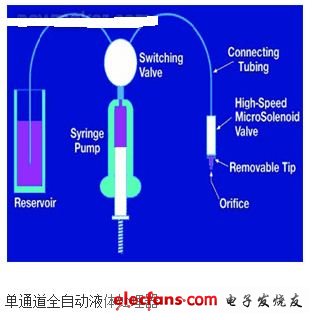Analysis of Fluid Control Technology in In Vitro Diagnostic and Scientific Analysis Instruments
Because the physical and static characteristics of different fluids are different, even if the physical dynamic characteristics of the same fluid medium under different environmental conditions are slightly different, these uncertain factors (variables) will increase the difficulty of design engineers to implement on-demand fluid control. Especially in the special occasions of medical diagnostic equipment and scientific analysis instruments, such as: large flow rate under low pressure conditions, requiring "high precision" for fluid control and meeting some professional application needs of medical instruments, system design engineers should strive to "balance" "Various confusing variables to achieve the development goal of the overall system performance. Based on the system universality of in vitro diagnostic equipment (referred to as "diagnosis") and scientific analysis equipment (referred to as "analysis"), this article briefly discusses some fluid control technologies and engineering solutions.
1. Liquid handling technology and automation solutions
Liquid treatment is also called "Sampling PrepearaTIon" and "pre-analysis treatment" in diagnosis and analysis. Its essence is to quantitatively aspirate and distribute the liquid to be tested (human body fluids, such as serum samples and urine). , Complete the dilution or mixing action.

So far, the principles of liquid treatment technology are nothing more than the following three types: liquid replacement, active replacement and gas replacement. The three principles have different needs for different applications. Among them, the latter two technologies are only used by a handful of manufacturers in automation products due to factors such as patents and technological processes. "Liquid replacement" is the earliest liquid processing automation technology that has been widely used and continues to this day.
As we all know, the micro syringe pump is a typical design based on the principle of liquid replacement. It is composed of the following key parts: micro-injector; shear valve and stepper motor with integrated drive, control and communication protocol. It can be directly applied to all diagnosis and analysis equipment that requires automatic sample preparation.
Obviously, in practical applications, the above-mentioned micro-syringe pumps cannot complete the dilution and distribution of liquids independently, so another key component is needed—aspirating / sampling needle (or probe). It can be connected to a certain function port of the shear valve on the microsyringe pump through the pipeline to form a "single-channel automatic liquid processor" as shown in the figure below, and then supplemented by a reasonable "association methodology agreement" software. Can create a professional dilution / dispenser for analysis and diagnostic laboratories. In the full-automatic liquid processing technology, the front-end sampling needle is the key part, because the needle shape at the end of the sampling needle must meet the actual application requirements, such as the puncture function and the liquid level detection function (LLD). The impact of sample accuracy and whether there will be "hanging beads" and other phenomena.
However, in some high-sensitivity diagnostic methodological applications (such as chemiluminescence immunoassay with a response sensitivity above 10-9), although the steel needle has also been subjected to some special treatments (such as: Teflon coating), However, after repeated cleaning and use for a period of time, "carrying pollution", "cross-contamination" and "dilution effect" will still result in false positives and false negatives of the diagnostic results, and even all batch tests will be invalid. Therefore, the EU IVDD 97 (In Vitro Diagnostic Equipment Directive) and the US Clinical In Vitro Diagnostic Guidelines both state that disposable TIp tips (tips) should be used. In this way, it is necessary to improve the part that directly contacts the liquid (ie, the front-end steel needle), transform the front-end part into a mechanical structure that can automatically dismount the disposable TIp head, and need to be embedded with high speed (response speed <3ms), very low internal Miniature electromagnetic medium isolation valve with volume and "zero" dead space. With the continuous innovation of diagnostic methodologies, the amount of sample added jumped from the "microliter" level to the "nanoliter" level, how to meet such high precision requirements? We can consider to achieve this by embedding a micro-fluid sensor on the front-end structure and supplementing it with a closed-loop peripheral control circuit.
The 1080P high-definition projectors on the market can be roughly divided into three grades: high, medium, and low. The low-end products are mainly aimed at the entry-level market. In terms of performance, they can fully meet the needs of watching various HD videos. In terms of adjustment, it tends to be simpler, mainly to allow entry-level users to quickly set up the projector, but the contrast of such projectors is generally not very high, and the overall picture effect is relatively general; mid-range projectors mainly have certain projector knowledge. , the projection picture also has a better performance, the most important contrast of the cinema projector has also been greatly improved, the projector adjustment tends to be more professional, and it is also equipped with various additional functions to improve the projection effect; high-end products are Mainly aimed at enthusiast players, both price and performance are the symbol of flagship. For commercial use, in addition to satisfying home entertainment applications, 1080P high-definition standard projectors can also support clear and delicate text and table content projection for business office applications that often conduct office text, PPT presentations, and video presentations. .
Full HD meeting room projector,best projector for video conferencing,portable business projector,high lumen projector,business 1080p HD projector
Shenzhen Happybate Trading Co.,LTD , https://www.happybateprojectors.com